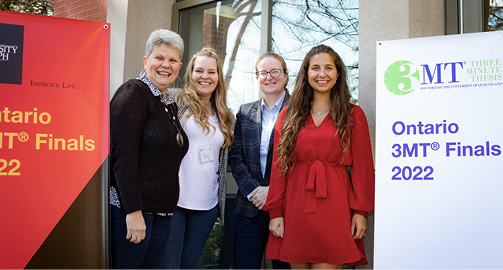Canadian PhD candidate Sarah de Blois, over the course of her research work at Laurentian University, has uncovered some thought-provoking statistics on the state of women in the mining industry.
Edited by Donna Schmidt

For the progress women in the mining industry have made over the years, it may be surprising to learn that there is actually much more still to be done. That is the picture of the state of the situation from Sarah de Blois, a PhD candidate in Laurentian University’s Human Studies and Interdisciplinary program. She is currently preparing to defend her dissertation Women, Mining and Gender: Experiences from Sudbury, Ontario with faculty supervisor Dr. Linda Ambrose and school committee members Dr. Parveen Nangia and Dr. Sara MacDonald.
de Blois, who began her PhD work in 2015, satiated her interest in organizational communication by developing a community-based research project fueled by feminist passion and a keen interest in workplace equity, diversity and inclusion. It was then that Greater Sudbury, a community which she said has established its reputation in the hyper-masculine milieu of mining, revealed itself as an ideal location to study gendered dynamics in the workplace. From there, it was exploring gender dynamics – and in particular, within the Canadian mining industry – that took a primary position in her research work.
“Deep-rooted gender issues in mining merit attention, and in leading my research whist keeping feminist principles in mind, it is my hope to positively contribute to the industry,” she noted in her interview with North American Mining magazine, noting her goal is to defend her work before the end of 2022.
It’s also worth noting that Sarah and her graduate research has won four merit-based Ontario Graduate Scholarships (OGS). Sarah is also a previous winner of a Social Sciences and Humanities Research Council Joseph-Armand Bombardier Canada Master’s Scholarship.
NAM: What spurred your interest in mining?
I’ve considered Greater Sudbury my home since 2007. Before then, home was located in the small community of Cochrane, about 400 kilometers (approximately 249 miles) north of Sudbury. Because I hone a particular interest in my community of Greater Sudbury, a city historically known as a “man’s town” given its initial establishment in the masculine milieu of mining, I wanted to research a topic central to my community that would find focus in better understanding the work experiences of underrepresented women in mining.
My husband has been a hard rock miner in Sudbury since 2009 and has rarely encountered women in his job. That the industry remains so heavily gender-imbalanced, contributes to its ongoing masculine organizational culture – a culture that my study sheds light on by providing a space for the voices of women workers to be heard.
Tell us more about your paper and research work.
My research focuses on understanding the gendered organizational culture of mining by studying the work experiences of women in mining. By speaking with women in the industry about their direct work experiences and workplace interactions, and men about their work experiences and workplace interactions in the industry with women, the purpose of my research was to understand the current gendered climate of the mining industry.
Mining contributes not only to the overall Canadian economy but is also important at local community level. According to recent statistics by the Mining Industry Human Resources Council (July 2022), women account for only about 17% of workers in mining. With the knowledge that employed women in the Canadian mining industry are so few and far in between, what is it like for women to work within these male-dominated workplace environments? How are they treated and communicated with by their colleagues and superiors? What are the challenges? What are the triumphs? These questions are but some of those that influenced my study.
What statistics from your work have you found surprising? What has not surprised you?
My research takes a qualitative stance in its understanding of the gendered culture and climate of the mining industry. Methods of analysis to consider the over 31 hours of interviewee data (N = 24 self-identified female interviewees and 11 self-identified male interviewees) found me integrating methods of critical discourse and thematic analysis to consider not only what participants said in their interviews but how they said what they did and in what context.
Surprising is how male-dominated the mining industry continues to be, even though many mining companies are taking a more proactive stance toward diversity in their hiring efforts. However, in a world that seems to be moving toward greater equality, diversity and inclusion, the hypermasculine mining industry seems to be moving slower than others. That my study discovered that resistance toward women in mining continues to exist, is concerning and contributes to this.
What I also discovered was that men continue to represent the quintessential worker in mining, especially in underground, blue-collar settings. My study discovered that women are, as a whole, less valued in the industry than are men, and that they perceive their efforts to prove themselves and their belonging more difficult than for male counterparts.
What have you found that should be worrisome for women in the industry, and for mining as a whole?
It is important to make clear that many positive experiences were described by women in mining who interviewed for my study. Most attested high levels of job satisfaction in the work that they perform. Many described achieving bonds of camaraderie with peers. However, these bonds were typically described by men and women alike, in masculine terms of reference. For example, becoming “one of the boys” or “one of the guys” represents the ideal sense of belonging in mining, revealing the masculine organizational culture still at large in the industry.
What’s worrisome is that though many women attested positive experiences in mining, most also described having experienced harassment or discrimination in their jobs. In terms of harassment, most common were experiences that sexually objectified women. A few women also spoke about encountering a gender pay gap where they perceive to be paid less for work of equal value in contrast to male peers.
For women in mining, challenging experiences that can be harassing or discriminatory most often occur near the beginning of their careers or upon movement to a new job site where they encounter new mostly male peers. These women rely on their resilience to overcome barriers to the achievement of acceptance and respect and necessitate toughness in doing so.
Do you feel this problem is global, or isolated only to a certain region?
That women in mining continue to experience gendered discrimination and harassment is problematic, revealing that much remains to be accomplished to ensure that mining workplaces offer safe and respectful environments for all workers. Everyone must contribute to inclusivity in mining, and all must hold themselves accountable for ongoing improvements to be made to this effect.
Notably, the literature tells us that it isn’t only the mining industry that is resistant toward women. Women encounter challenges of acceptance in other industries as well, especially in those conventionally labelled “blue-collar” where jobs offered have longstanding been considered better suited for men than women. Ideologies based on gender essentialism contribute to ongoing gendered occupational segregation, and it is important to take a careful look within to ensure that any stereotypes held about gender are dispelled.
What example do you think the Canadian industry can set for other mining-rich regions?
Mining is an essential industry across the globe, and internationally, Canada is a leading country producing minerals and metals. As industry leaders, it is the responsibility of the Canadian mining industry to also guide dialogue about the necessity of diversity and inclusion in the industry. Workers bring unique talents with them to mining, and by recognizing that diversity of workers, including women, is itself essential, a healthier resource base of leadership and skills can be built, and current performance in safety, health and wellness may also be improved. This has potential to increase confidence in the future of the mining industry.

Professor of History, Laurentian University; Stacy Sathaassevan,
graduate information officer, Laurentian University; Dr. Tammy Eger,
vice president, Research, Laurentian University; and Sarah de Blois.
How do you hope your work will change this issue?
It is my hope that my research will shed light on imbalances and inequalities still present in Canada’s mining industry, especially for women. My study hopes to spark improvements to this effect. While progress that takes steps toward enhanced equity, diversity and inclusion have been made, much remains to be accomplished.
My study helps to bring awareness to these necessary improvements to ensure that all workers feel safe and welcome within their places of employment. Women in mining must be considered a sustainability imperative. Their potential to contribute to the success of the industry needs to be respected, and my study draws important attention to this. With any luck and effort on my part to share my findings, my research may catalyze improved policies and training practices in mining to build a more inclusive industry.
